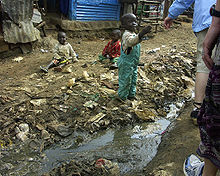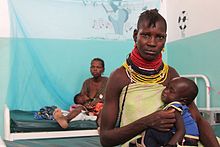Undernutrition in children
The World Health Organization (WHO) estimates that malnutrition accounts for 54 percent of child mortality worldwide,[5] which is about 1 million children.
[12] These measures of malnutrition are interrelated, but studies for the World Bank found that only 9 percent of children exhibit stunting, underweight, and wasting.
[1] Children with severe acute malnutrition are very thin, but they often also have swollen hands and feet, making the internal problems more evident to health workers.
[5] Undernutrition in children causes direct structural damage to the brain and impairs infant motor development and exploratory behavior.
[14] Children who are undernourished before age two and gain weight quickly later in childhood and in adolescence are at high risk of chronic diseases related to nutrition.
Of these side effects, there is an emphasis on addressing the increased risk of hypoglycemia, hypothermia, cardiac failure, and the likelihood of missing the presence of an infection.
[14] Children who are undernourished are more likely to be short in adulthood, have lower educational achievement and economic status, and give birth to smaller infants.
[16] Inadequate food intake, infections, psychosocial deprivation, the environment (lack of sanitation and hygiene), social inequality and perhaps genetics contribute to childhood malnutrition.
[citation needed] The World Health Organization estimated in 2008 that globally, half of all cases of undernutrition in children under five were caused by unsafe water, inadequate sanitation, or insufficient hygiene.
[1] Studies in Bangladesh in 2009 found that the mother's illiteracy, low household income, higher number of siblings, less access to mass media, less supplementation of diets, unhygienic water and sanitation are associated with chronic and severe malnutrition in children.
In 2011 UNICEF reported that 30 percent of households in the developing world were not consuming iodized salt, which accounted for 41 million infants and newborns in whom iodine deficiency could still be prevented.
[14] Short stature of the mother and poor maternal nutrition stores increase the risk of intrauterine growth retardation (IUGR).
[19] Other studies show that, at the national level, differences between undernutrition prevalence rates between young boys and girls are generally small.
[1] Iodine supplement trials in pregnant women have been shown to reduce offspring deaths during infancy and early childhood by 29 percent.
[13] The Progresa program in Mexico combined conditional cash transfers with nutritional education and micronutrient-fortified food supplements; this resulted in a 10 percent reduction in the prevalence of stunting in children 12–36 months old.
However, research has shown that Soy Kunu, a locally sourced and prepared blend consisting of peanut, millet, and soya beans, contains the components of the Ready to Use Therapeutic Food (RUTF) and this has been used massively to reduce malnutrition in the north.
[2] This confirms the recommendation, "In addition to the provision of RUTF [ready-to-use therapeutic food], children need to receive a short course of basic oral medication to treat infections."
"[33] The World Health Organization estimates that malnutrition accounts for 54 percent of child mortality worldwide,[5] about 1 million children.






